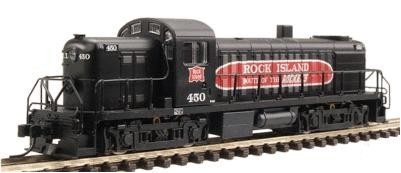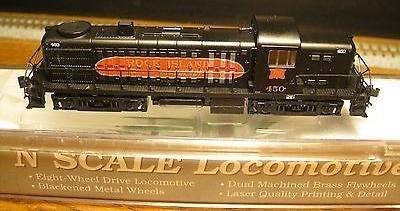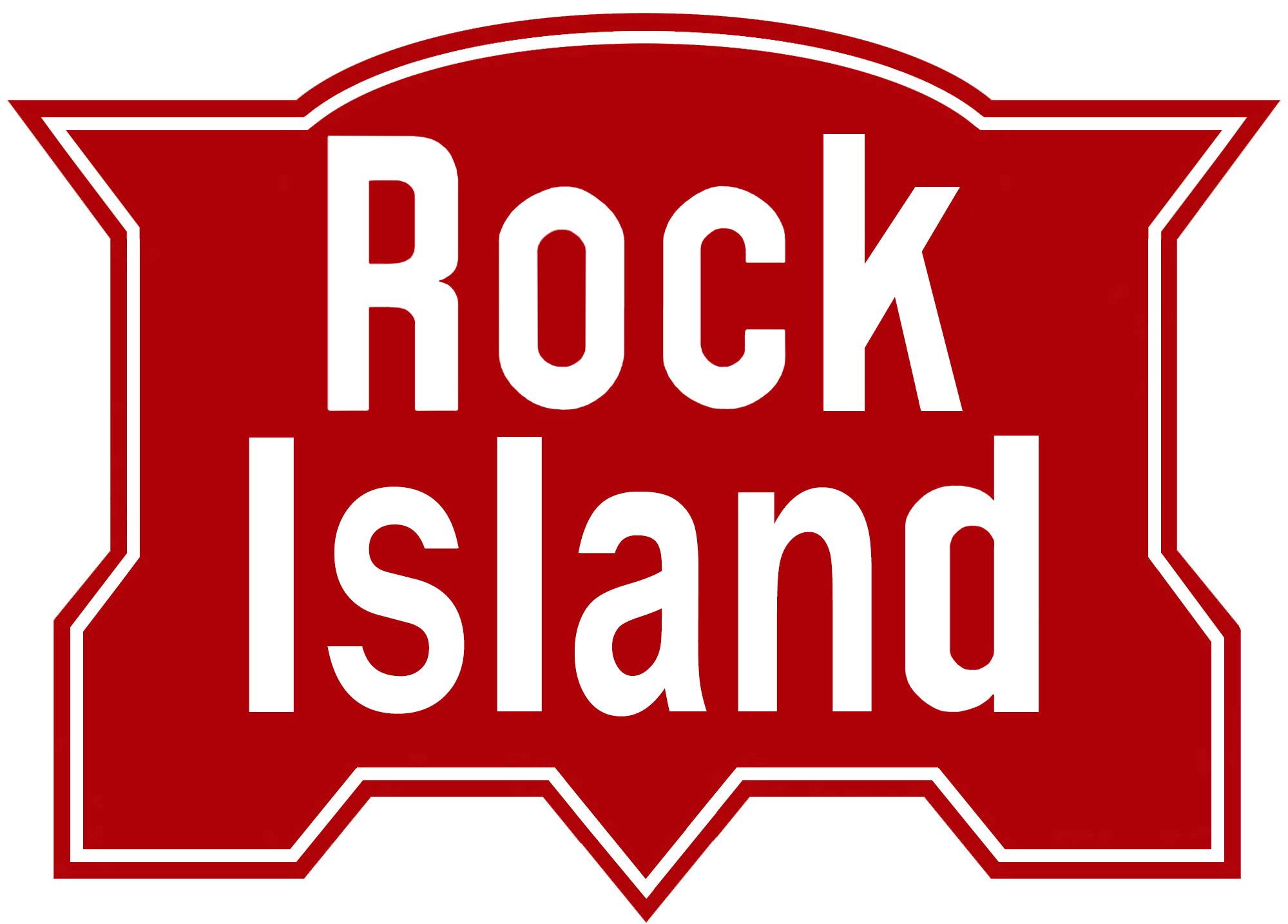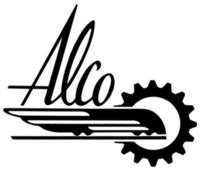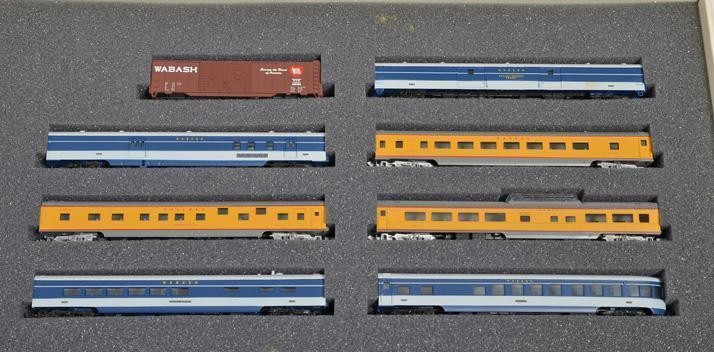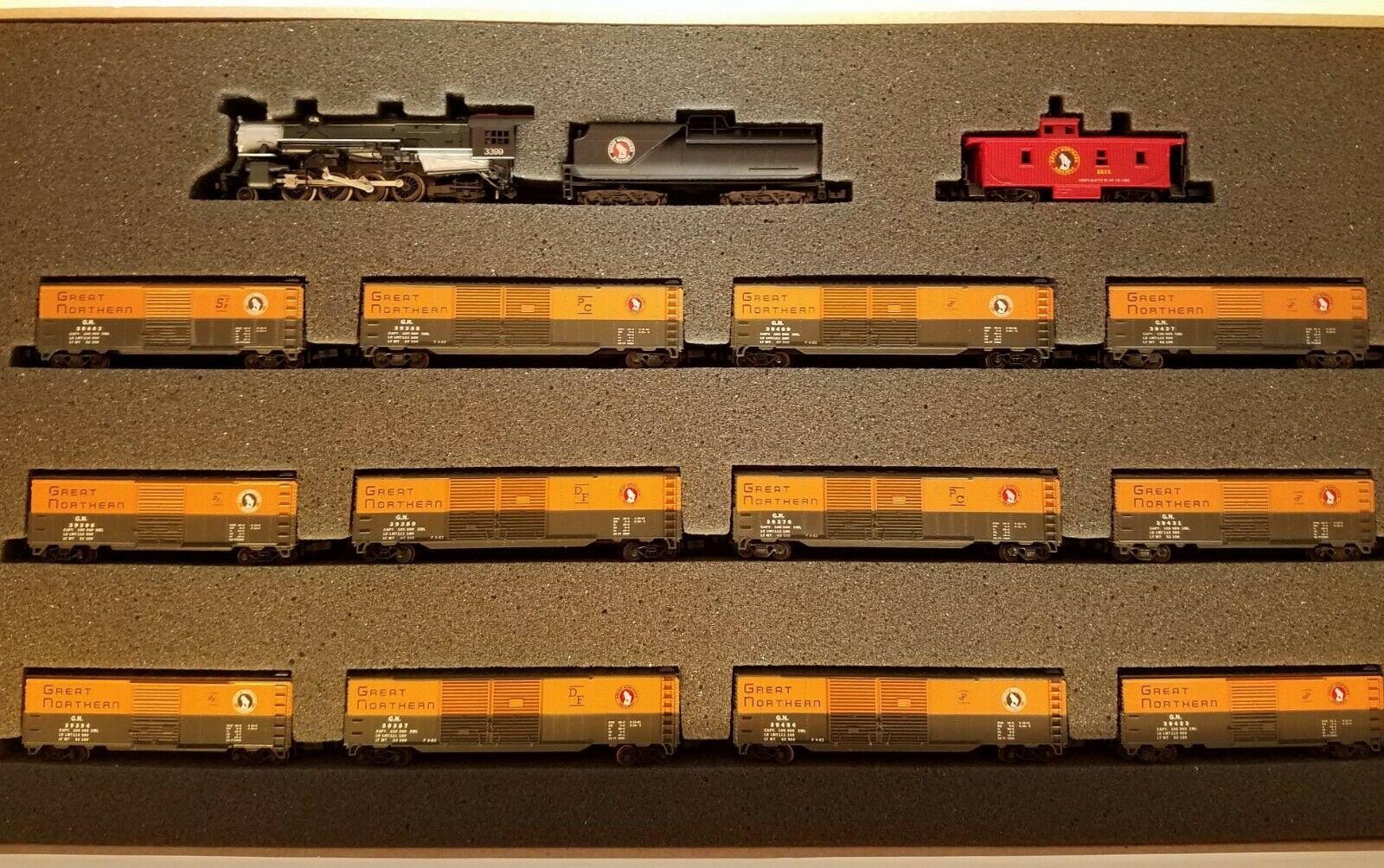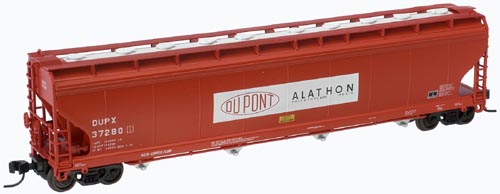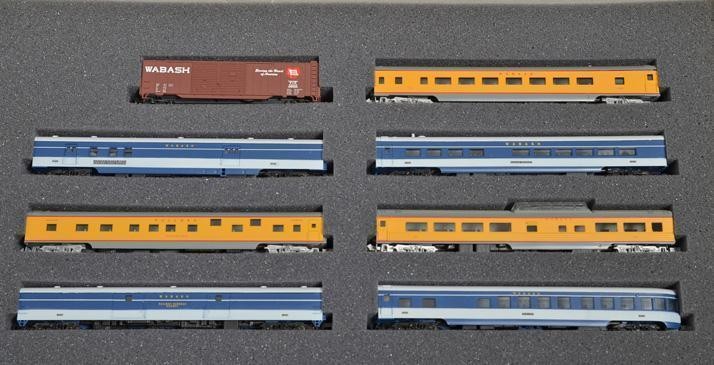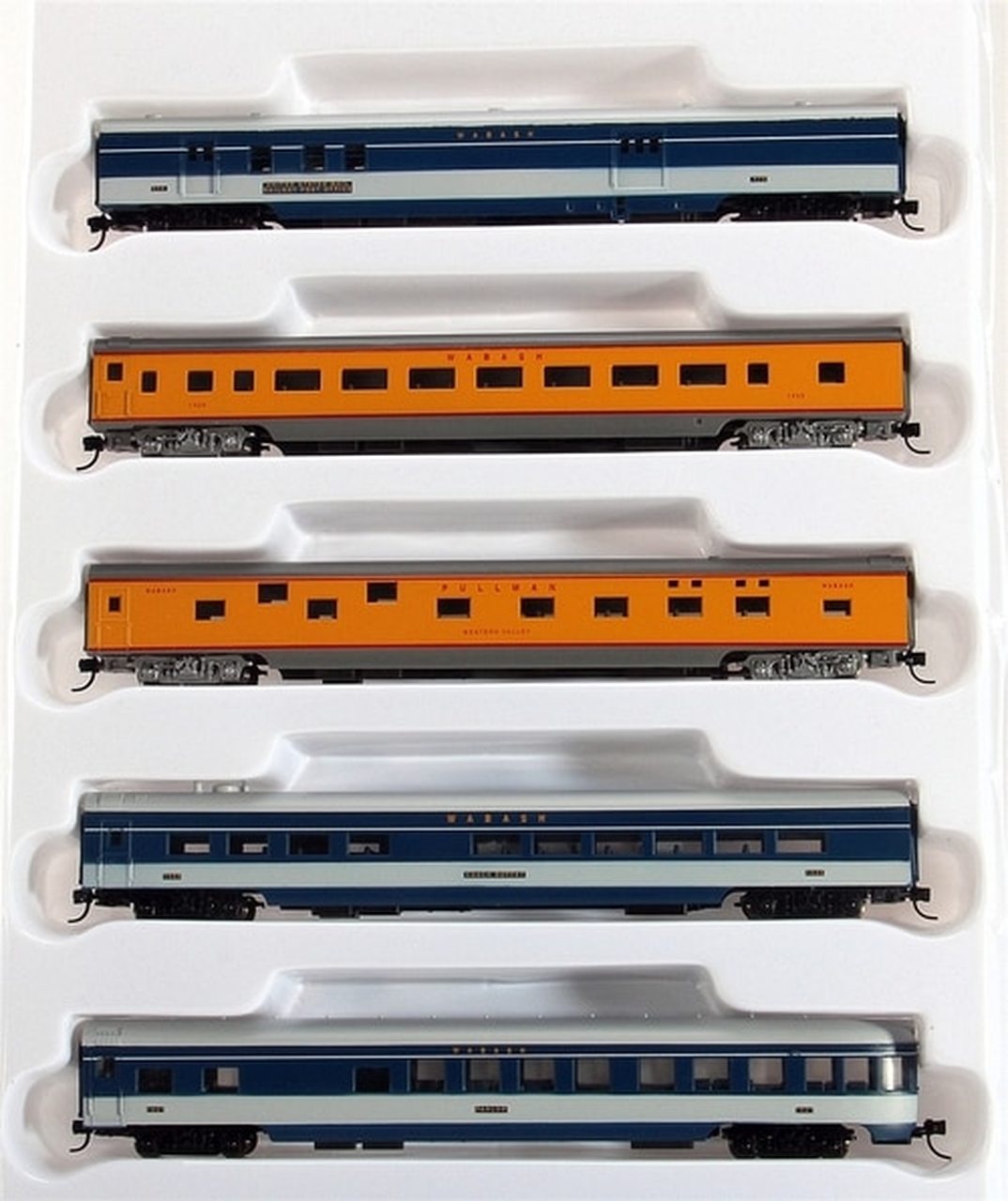Model Information: First released in 2007. Subsequent releases in 2008, 2011 and in 2012 (with MTL couplers). A fifth release was announced in 2012, but eventually cancelled due to insufficient reservations.
Re-run under Atlas brand in 2019 after Atlas purchased the tooling from Walthers.
Features:
Re-run under Atlas brand in 2019 after Atlas purchased the tooling from Walthers.
Features:
- split-frame, all-metal, DCC-Friendly chassis,
- 5-pole skew-wound "scale speed" motor, with dual flywheels,
- low-friction drive,
- bi-directional LED lighting,
- all-wheel drive and pickup (no traction tires),
- blackened, low-profile wheels,
- body-mounted Accumate couplers.
DCC Information: Contrary to the above review, due to the amount of effort required to install a decoder, we elected to classify this as DCC-Friendly.
Accepts the following plug-in decoders (non-sound), but requires a full disassembly of the locomotives, and proper isolation of the motor from the chassis with insulating tape:
- Digitrax DN163K2: 1 Amp N Scale Mobile Decoder for Kato N scale SD80/90MAC Series, RSC2, RS2. See installation tips on Digitrax website.
- TCS K2D4: N-scale drop-in decoder designed for Kato RS2/RSC2, SD80/SD90MAC and Life-Like/Walthers RS2, GP18 locomotives. See installation tips on TCS website.
The Atlas version of 2019 comes either with a factory-installed DCC decoder or in DC version.
Accepts the following plug-in decoders (non-sound), but requires a full disassembly of the locomotives, and proper isolation of the motor from the chassis with insulating tape:
- Digitrax DN163K2: 1 Amp N Scale Mobile Decoder for Kato N scale SD80/90MAC Series, RSC2, RS2. See installation tips on Digitrax website.
- TCS K2D4: N-scale drop-in decoder designed for Kato RS2/RSC2, SD80/SD90MAC and Life-Like/Walthers RS2, GP18 locomotives. See installation tips on TCS website.
The Atlas version of 2019 comes either with a factory-installed DCC decoder or in DC version.
Prototype History: The ALCO RS-2 is a 1,500–1,600 horsepower (1,100–1,200 kW) B-B road switcher diesel-electric locomotive built by the American Locomotive Company (ALCO) from 1946 to 1950. ALCO introduced the model after World War II as an improvement on the ALCO RS-1. The locomotive was one of several road switchers in a crowded market, including the Baldwin DRS-4-4-1500, EMD GP7, and FM H-15-44. ALCO discontinued the RS-2 in 1950 in favor of the ALCO RS-3. Several examples have been preserved.
383 locomotives were produced — 374 by the American Locomotive Company, and 9 by Montreal Locomotive Works in Canada. Eight of the ALCO RS-2s were exported to Canada. The RS-2 has a single, 12 cylinder, model 244B engine, developing 1,500 horsepower (1,100 kW). Thirty-one locomotives built by Alco between February and May 1950 with the 12 cylinder 244C 1,600 horsepower (1,200 kW) engine.
From Wikipedia
Read more on American-Rails.com
383 locomotives were produced — 374 by the American Locomotive Company, and 9 by Montreal Locomotive Works in Canada. Eight of the ALCO RS-2s were exported to Canada. The RS-2 has a single, 12 cylinder, model 244B engine, developing 1,500 horsepower (1,100 kW). Thirty-one locomotives built by Alco between February and May 1950 with the 12 cylinder 244C 1,600 horsepower (1,200 kW) engine.
From Wikipedia
Read more on American-Rails.com
Road Name History: The Chicago, Rock Island and Pacific Railroad (CRI&P RR) (reporting marks RI, ROCK) was a Class I railroad in the United States. It was better known as the Rock Island Line, or, in its final years, The Rock. At the end of 1970 it operated 7183 miles of road on 10669 miles of track; that year it reported 20557 million ton-miles of revenue freight and 118 million passenger-miles. (Those totals may or may not include the former Burlington-Rock Island Railroad.)
Its predecessor, the Rock Island and La Salle Railroad Company, was incorporated in Illinois on February 27, 1847, and an amended charter was approved on February 7, 1851, as the Chicago and Rock Island Railroad. Construction began October 1, 1851, in Chicago, and the first train was operated on October 10, 1852, between Chicago and Joliet. Construction continued on through La Salle, and Rock Island was reached on February 22, 1854, becoming the first railroad to connect Chicago with the Mississippi River.
In 1980 Rock Island was liquidated. The railroad's locomotives, rail cars, equipment, tracks, and real estate were sold to other railroads or to scrappers. William Gibbons (the trustee) was able to raise more than $500 million in the liquidation, paying off all the railroad's creditors, bondholders and all other debts in full at face value with interest. Henry Crown was ultimately proven correct, as both he and other bondholders who had purchased Rock Island debt for cents on the dollar during the low ebb in prices did especially well.
Read more on Wikipedia and Rock Island Technical Society.
Its predecessor, the Rock Island and La Salle Railroad Company, was incorporated in Illinois on February 27, 1847, and an amended charter was approved on February 7, 1851, as the Chicago and Rock Island Railroad. Construction began October 1, 1851, in Chicago, and the first train was operated on October 10, 1852, between Chicago and Joliet. Construction continued on through La Salle, and Rock Island was reached on February 22, 1854, becoming the first railroad to connect Chicago with the Mississippi River.
In 1980 Rock Island was liquidated. The railroad's locomotives, rail cars, equipment, tracks, and real estate were sold to other railroads or to scrappers. William Gibbons (the trustee) was able to raise more than $500 million in the liquidation, paying off all the railroad's creditors, bondholders and all other debts in full at face value with interest. Henry Crown was ultimately proven correct, as both he and other bondholders who had purchased Rock Island debt for cents on the dollar during the low ebb in prices did especially well.
Read more on Wikipedia and Rock Island Technical Society.
Brand/Importer Information:  Life-Like Products LLC (now Life-Like Toy and Hobby division of Wm. K. Walthers) was a manufacturer of model railroad products and was based in Baltimore, Maryland.
Life-Like Products LLC (now Life-Like Toy and Hobby division of Wm. K. Walthers) was a manufacturer of model railroad products and was based in Baltimore, Maryland.
It was founded in the 1950s by a company that pioneered extruded foam ice chests under the Lifoam trademark. Because ice chests are a summer seasonal item, the company needed a way to keep the factory operating year round. As model railroading was becoming popular in the post-war years, they saw this as an opportunity and so manufactured extruded foam tunnels for model trains. Over the years, Life-Like expanded into other scenery items, finally manufacturing rolling stock beginning in the late 1960s. At some point in the early 1970s, Life-Like purchased Varney Inc. and began to produce the former Varney line as its own.
The Canadian distributor for Life-Like products, Canadian Hobbycraft, saw a missing segment in market for Canadian model prototypes, and started producing a few Canadian models that were later, with a few modifications, offered in the US market with US roadnames.
In 2005, the company, now known as Lifoam Industries, LLC, decided to concentrate on their core products of extruded foam and sold their model railroad operations to Wm. K. Walthers.
In June 2018, Atlas and Walthers announced to have reached an agreement under which all Walthers N scale rolling stock tooling, including the former Life-Like tooling, will be purchased by Atlas.
Read more on Wikipedia and The Train Collectors Association.

It was founded in the 1950s by a company that pioneered extruded foam ice chests under the Lifoam trademark. Because ice chests are a summer seasonal item, the company needed a way to keep the factory operating year round. As model railroading was becoming popular in the post-war years, they saw this as an opportunity and so manufactured extruded foam tunnels for model trains. Over the years, Life-Like expanded into other scenery items, finally manufacturing rolling stock beginning in the late 1960s. At some point in the early 1970s, Life-Like purchased Varney Inc. and began to produce the former Varney line as its own.
The Canadian distributor for Life-Like products, Canadian Hobbycraft, saw a missing segment in market for Canadian model prototypes, and started producing a few Canadian models that were later, with a few modifications, offered in the US market with US roadnames.
In 2005, the company, now known as Lifoam Industries, LLC, decided to concentrate on their core products of extruded foam and sold their model railroad operations to Wm. K. Walthers.
In June 2018, Atlas and Walthers announced to have reached an agreement under which all Walthers N scale rolling stock tooling, including the former Life-Like tooling, will be purchased by Atlas.
Read more on Wikipedia and The Train Collectors Association.
Item created by: Alain LM on 2018-08-10 05:02:56. Last edited by Alain LM on 2020-10-12 04:25:43
If you see errors or missing data in this entry, please feel free to log in and edit it. Anyone with a Gmail account can log in instantly.
If you see errors or missing data in this entry, please feel free to log in and edit it. Anyone with a Gmail account can log in instantly.


